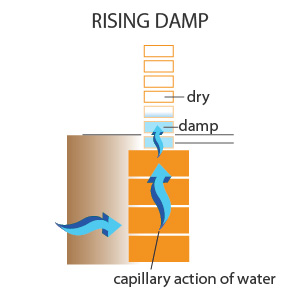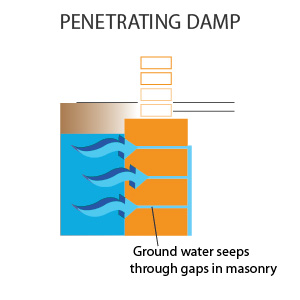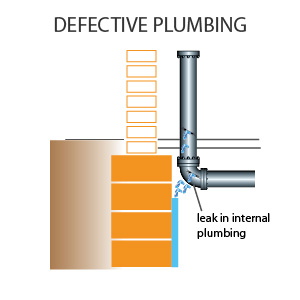The Types of Damp in Your Basement
Our homes can suffer from four main types of damp. More often than not, basements are subject to a combination of these types of damp to varying degrees. It is important to identify the true cause of dampness in your property so that the correct solution(s) can be implemented.
1. Rising Damp
Rising damp is caused by water rising up through and penetrating the building’s fabric, and can be present in both external and internal walls of the property. Many basements are prone to rising damp, as they lie wholly or partially below the damp proof course. Rising damp can be identified from a ‘tide mark’ near the bottom of the walls that is present all year round, although may be more prominent in the winter months. In severe cases, changes in the water table levels may result in the basement floor becoming submerged.
Black mould is unlikely to be present with rising damp due to the ground salts drawn in by the moisture.


2. Penetrating Damp:
Penetrating damp is only seen in external walls and is often caused by a defect on the outside of the property such as leaking gutters, defective pointing, changes in external ground levels or uncapped chimneys. The affected areas both look and feel damp, and are often more noticeable after a period of rainfall. Penetrating damp would most likely be seen towards the ceiling of the basement, close to the ground level. Again black mould growth is unlikely to be present as the areas remain too wet and salts are present.
3. Condensation:
Condensation occurs when warm air comes into contact with the cooler surfaces of cellar walls and condenses into water droplets. Condensation is by far the most common cause of dampness in basements, especially when there is little air circulation. How much condensation occurs is dependent upon the temperature of the home, and the actions of its residents in terms of how much water vapour is produced.
Condensation is usually accompanied by the presence of black mould.


4. Defective Plumbing:
Most common to kitchens and bathrooms, but can also be seen in cellars around the entry point of the mains water pipe or close to mains drainage. The area looks and feels damp, irrespective of weather conditions.
